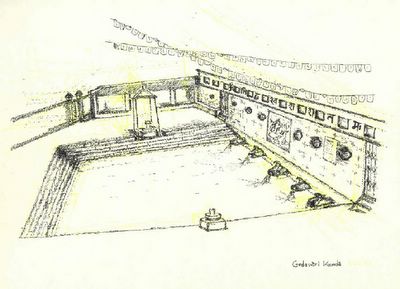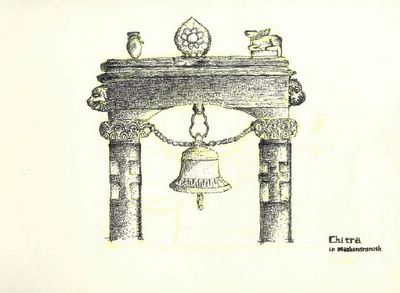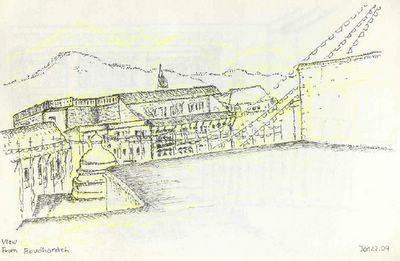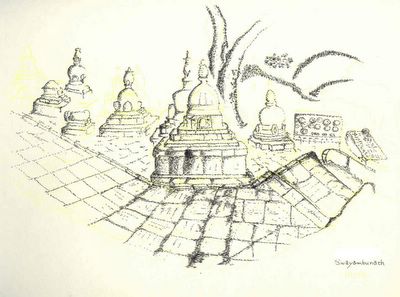Whenever I visited Kathmandu, Nepal, I used to stay at Yak Lodge. The residence is simple and unpretending lodge located on the upper floors of Yak restaurant in Thamel, a famous tourist area in Kathmandu. The restaurant and lodge are managed by a warm-hearted Tibetan family. Delicious western, Chinese, Indian cuisine and some local food are served at reasonable prices. It had been my second home in Nepal for ten years.
You meet easily the simple and poor villagers around Kathmandu. They look happy even if they are not rich, don't have luxury cars and houses. They like smiling and laughing so much.
Bigu means nun in Tibetan and Gompa monastery or nunnery. This Tibetan Buddhist nunnery is located in the mid-slope of Mt. Shiva Puri in northern Kathmandu, which is one of the highest mountains surrounding Kathmandu Valley.
When I went there in 2002, about 20 Tibetan nuns stayed there. They welcomed me friendly, and some Tibetan cakes and tea were served. The picture above is the main building of the nunnery, where rituals including prayer and offering are performed. Dharma Wheel flanked by two deer in the front of the roof is also seen.
In Kathmandu, Nepal, there are two viewpoints to enjoy the snow covering Himalayan range. They are Nagarkot and Kakani. Nagarkot in the east of Kathmandu and Kakani in the west are famous for its sunrise and sunset respectively. The road to Kakani and Trisuli Bazar is lined with traditional and simple houses, and numerous small villages are seen on the mountains.
The drawing on the right is described as one of the houses in those villages. Little big villages have small shops selling goods and tea. Enjoying traditional Nepali tea(Chya) or fermented milk drink(Lassi) is another pleasure of hiking here.
Godavari is a peaceful village located in the south of Kathmandu valley, Nepal. The road from Patan runs to Godavari, passing through typical Nepali villages. Royal Botanical Garden in Godavari, the only botanical garden in Nepal is worth a visit.
Godavari Kunda is very close to the botanical garden. Kunda means a holy spring in Nepali. The water is fresh, crystal clear and cold. A big mela(festival) is held every 12 years and many pilgrims come to take bath, drink, and worship. People believe that all the skin diseases can be cured after taking bath here. This Kunda is a pilgrimage place revered by both Hindus and Buddhists. The water is channeled through 5 carved stone spouts. Each spout represents Makara, a mythological water creature that looks like a crocodile.
The upper ones are prayer flags, "Tarcho" in Tibetan, on which Buddhist scriptures are written.
Asan Tole, which is the heart of the market district and one of the busiest squares in Kathmandu, Nepal, has six roads radiating from it. The square is almost always crowded with shoppers.
The 6 narrow roads, that radiate from the open-air fruit and vegetable market surrounding Annapurna temple, are lined with many shops selling all kinds of household goods, dried fishes, cassette tapes, clothing, incense, footwear and spices including saffron, cardamom and many masala spice mixes that are so essential to Nepali and Indian cooking. Apart from Asan's cultural importance, it has a glorious history as a trade center. The diagonal street that passes through here was part of the legendary trade route connecting Tibet and India.
The three-roofed metal pagoda on the left is Annapurna (goddess of food grains) temple. There is only a big silver jar called kalash inside the temple for an image of Annapurna. Across the square from this temple is a two-story pagoda temple dedicated to Ganesh (the half-man, half-elephant god).
Two days before I sketched this in 2002, Maoists had called for the general strike(Bandh) across the country. Strike called by Maoist rebels in Nepal are usually strictly obeyed for fear of brutal retaliation. Businesses, markets, and schools closed in the capital. All the shops in Asan Tole were also closed and the square was so silent.
Near the old Bazar, Asan Tole, there is Machendranath Mandir dedicated to a rain god. Machendranath, who is an aspect of the Bodhisattva Chenrezig, the patron saint of Tibet is worshiped by Hindus and Buddhists alike. Hindus consider him to be an incarnation of Shiva, too.
They have several statues and bells surrounding the main temple. People ring the bells as an expression of worship. Many Hindus and Buddhists visit this temple to worship and pray in the morning and enjoy listening to Bhajan, a Hindu devotional song. A flock of pigeons also awaits the visitors.
A great stupa called Boudhanath is in the northeast of Kathmandu, Nepal. As the focal point of Tibetan Buddhism in Nepal, it has been a holy and mysterious stupa among Buddhists as well as Hinduists for a long time. Many Tibetans, Tibetan restaurants, tourists, and monasteries are seen around it.
The sketch on the right side is a view from Boudhanath Stupa. This was drawn facing north, sitting on either side of the stupa.
* Stupa: Buddhist commemorative monument usually housing sacred relics associated with the Buddha or other saintly persons. The hemispherical form of the stupa appears to have derived from pre-Buddhist burial mounds in India. As most characteristically seen at Sanchi in the Great Stupa (2nd~1st century BC), the monument consists of a circular base supporting a massive solid.(Encyclopedia Britannica)
Thahiti Tole is the square near Small star restaurant and is located south of Thamel, the most popular tourist district in Kathmandu, Nepal. Thahiti is also a market square with a stupa at its center as shown in the sketch above.
Five small roads lead to Thahiti Tole which is dusty in the dry season as most parts of the city. Cars, rickshaws and motorbikes raise a lot of dust in daytime and shop-keepers sprinkle water to lay the dust at times. I had a cup of Nepali tea at a restaurant in the square and sketched the view briefly.
About 2500-year-old Buddhist temple called Swayambunath is located on a hill in the eastern Kathmandu, Nepal. This has been known to be one of the most mysterious, historical and religious places in Nepal. Various religious symbols as statues and Stupas including Hinduism ones are seen in the peaceful atmosphere. It also offers a panoramic view of Kathmandu city and the Himalayas.
This temple is also called Monkey Temple as many monkeys live on and around the hill. You can reach at the top of the hill after ascending the 365 steps and then see a huge and white hemisphere of Stupa. The pictures were sketched near the Stupa and somewhere along the steps respectively. Tibetan and Nepali vendors selling unique handmade gifts along the steps await tourists.
After Osho Rajneesh's death, one of Osho's intimate disciples set up Osho Tapoban somewhere in the dense forest of Nagarjuna near Kathmandu. Nagarjuna(circa AD 150 - 250) who was an important figure of Mahayana Buddhism was said to be enlightened in this forest. Osho Tapoban has attracted spiritual seekers around the world. In the early period of the retreat center, I also used to be one of the participants to join the meditation sessions conducted there. Osho's teaching was centered on all meditation activities.
The above drawing shows Osho Samadhi located in the lower place of the retreat center, worshiped by all Osho followers. Some of Osho's ashes are buried in the middle of round-shaped Samadhi made of marbles. Flowers are offered and incense burned.
Wherever you see a beauty: in a human face, in a child's eye, in a lotus flower, in the wings of a bird in flight, in the rainbow or in a silent rock, remember you are on the Holy ground - God is close. -OSHO-












